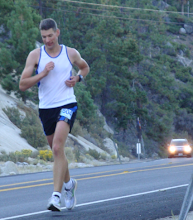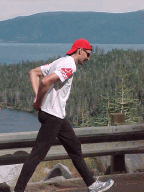
But that is not the maturity level that I am referring to. Instead, it is my adolescent period of running which after 7 years I find myself wanting to do more than I’m probably trained for. A time when as my mother often told me “your eyes are bigger than my stomach,” but I still pile the food higher on my plate.
As I returned from Western States at the end of June I became convinced that my obsession with not posting a “DNF” (did not finish) has hindered my finish times and left me guessing at my true ability. Crazy and random thoughts surged thru my head; questions about my desire to suffer late in a race, questions about what I’m trying to prove to myself or anyone else, questions about why I’ve become obsessed with these new found challenges that exhaust both my physical and mental abilities, questions that sometimes just should not be asked by any sane person.
This is but a glimpse of a runner suffering from an obsession and returning to the 1st 100-mile race he ever ran. Vermont was a race that I foolishly lost some respect for after 3 feet bruising years on the rocks at Massanutten. Certainly, I could run under 24 hours at Vermont with its modest elevation changes and very run-able road surface, especially with my new attitude! Only one problem arose for me “there is no easy 100” and when you begin losing respect for something that’s when you get hurt.
The plane trip to New England found me in a sophomore slump, which only worsened as the day progressed and the gray skies began dumping rain. For some reason I was having problems getting excited for this run. I enjoyed continuing friendships made at the Western States (WS) but still did not find the emotional spark I so desperately needed to run well.
Friday morning I slept until 8:30 before having a leisurely breakfast and reading the local paper, taking a walk and a mid-day nap. Now this was a lifestyle I could get used to! Pre-race check-in and medical check ended around 3 pm so I planned to arrive at 2pm, take care of requirements, eat from the pasta buffet and return to the hotel by 7pm for as much sleep as possible.
2am Saturday morning I was awake before the alarm ever got close to sounding. Preparation was quick with a final gear check, packing the car, and exit of the hotel since there would be no need for a room on Saturday night. By 3:15am I was standing in the main tent just 20 yards from the start line. Yep, still no emotional spark, no butterflies in my stomach, nothing – just conversation with other runners and a clear understanding that it was going to be a long day.
4am we were off and running downhill, I tried to settle into a rhythm and soon found other runners that I knew to team up with and banter about life and running. The race unfolded rather quickly and I mean quickly as I ran a bit faster than anticipated or within good judgment for my adolescent skills. 25 miles rolled by in 4 hours/25 minutes and 30 miles in 5 hours/38 minutes. Neither of these times was reasonable for me to sustain over a 100-mile course, especially with two races of equal distance within the past nine weeks. I should have slowed myself down but immaturity prevailed.
Other than a goal of finishing in 24 hours I had not set any major targets for myself. I carried a split sheet in my pocket just like WS but never looked at it. One nice aspect of running faster than I should was the large number of people I talked with in the first 50 miles. Runners whom I would never normally have opportunity to talk with because they should be miles in front of me, which they were by the end of the race! Another nice feature was seeing more of the horses sharing the course with us on the same day. Vermont is the last remaining 100-mile race where horses and runners co-exist.
At Camp 10 Bear aid station (“C-10B”, mile 47.2 – 1:19pm) the Vermont heat and humidity was beset upon us but not nearly as oppressive as prior years and I was still ahead of my planned pace feeling reasonably strong and confident. The next 23.8 miles would bring us through a complete circle of the Vermont countryside before returning to C-10B and a final push for home.
This loop is where I lost control in 2003, neglecting to pick up my flashlights and warm clothing from an aid station and having to return several hundred yards to retrieve them or DNF in the fading light. No worries this year as I found my way to the famed Margaritaville aid station (mile 62.1) and enjoyed a few moments chatting with the party goers and eating a cheeseburger in paradise, after all it was named after the infamous Jimmy Buffett. As I rolled out of Margaritaville the clock was still in my favor and my mental stamina remained strong believing that 24 hours was within my reach.
The second time through C-10B (mile 70.1 – 7:07pm) I had budgeted a significant amount of time to compose myself and change equipment for the last 30 miles. Shoes, socks, warmer shirt, lights and complete restocking of nutrition were all planned for and completed. The aid station was bustling, as it becomes the location from which most runners collect their pacers for the final miles and support crews offer emotional support.
While I had run Western States with Pete Lubbers as my pacer and had a blast, the remaining three Grand Slam races I am running without support crew or pacers. Yes, I have become intensely aware that crews and pacers can save time in aid stations and help protect a runner from suffering the consequences of “ultra brain” and “stupid mistakes” often even saving one’s race. I suppose a significant part of the challenge to me is completing these runs as man (or adolescent) against the trails. Because of this I knew the last 30 miles would be dark and lonely.
The next major mental target was to reach the aid station named Bill’s (mile 88.6). In 2003, the 90-mile mark had brought me to my knees, well actually my backside as I succumbed to my desire for sleep at 2am in my first 100-mile race. Since then I have not surrendered to the sleep monster but have fought with it on many levels.
At Bill’s aid station I received my first glimpse that the 24-hour goal was in serious jeopardy. I had slipped from running 45 minutes ahead of pace at C-10B to 30 minutes behind with only 11.4 miles to go, it was now 1am and 21 hours into the race, 3 hours to go. Once again the race was on and I was beginning to feel emotionally distraught, as I so desperately wanted to finish within my goals.
Sleep--walking was interspersed with running as I would summon up the energy and force myself to engage the internal battle for more speed. For hours my brain had tried to calculate splits and finish times based on different scenarios playing out in my head but with only a few short miles left there were less and less scenarios to play out and trails that seamed to stretch longer and longer beyond my small tunnel of light.
Upon reaching Polly’s aid station (mile 95.5) I believe my will and desire finally gave in as the reality of needing to cover 4.5 miles within 37 minutes (an 8.25 minute per mile pace) became impossible for my weary legs. This was just not going to happen, so I mentally conceded defeat of my 24-hour goal and drank another cup of soup to warm my body and replenish salt and fluids. The remaining miles took 23.5 minutes per mile, my slowest of the day.
Perhaps a significant slowdown over the final miles of a 100-mile run should be expected as the combination of sleep deprivation, emotional drain, and physical trauma catches up but those reasons do nothing to calm my lingering dissatisfaction with personal performance still resident within my mind weeks after the finish line has been crossed.
Am I upset? Only by missed opportunities. To run 100 miles and finish in 25 hours, 9 minutes is still quite an accomplishment for many and as an immature runner becomes my second fastest time at the distance. Upon review of the numbers I’m convinced that the goal was not lost in the final miles but in the first 30 when the little boy in me took control and I played with my friends in the woods of Vermont.
What’s next? – Leadville Trail 100, “The Race Across the Sky”.
How will my body react to no oxygen? This race’s historical finish rate is less than 50%!!!
Dave Yeakel, Jr. (#212 – out)
77th of 144 finishers with 199 starters
Grand Slam Update:
30 registered runners / 5 DNF’s at Western States / 2 DNF’s at Vermont – 23 still running.



 The end of the 9-mile loop
The end of the 9-mile loop
















 Lined up for the (all-male) start
Lined up for the (all-male) start



 How do you spell Lubbers?
How do you spell Lubbers?
 Real estate bargains in Sant' Agata dei Goti
Real estate bargains in Sant' Agata dei Goti











